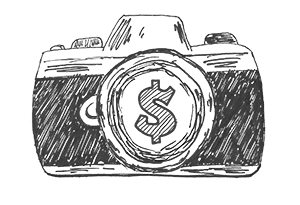Camera lens filters explained
Lens filters fit on the end of a lens by either dropping into a framework that mounts on the lens, or by screwing directly to the lens. You can pay as little as $20 or over a thousand dollars. It depends on the quality of the product and in some cases the brand name.
So I’ll take you through the different types of filters available.
Close-up Filters
If you like to take photos of insects you will need a macro lens. That is a lens that can get close to the subject and capture the details. If another expensive lens is out of your budget then you need some close-up filters.
These are the equivalent of reading glasses for your lenses. They screw fit on the end of your lens and come in different diopter strengths from +1 to +10. The higher the diopter number the higher the magnification. I haven’t used these, but I think I’ll give them a try. You can get a kit with +1, +2, +4, & +10 diopter strength filters for $20.
Color Correcting Filters
These filters allow you to make the scene warmer or cooler. I really don’t see the need for these, as you can use presets in Lightroom, or filters in Photoshop to do the same thing. These may be a throwback to the days of film cameras. If you want to do the same thing in the studio you would use colored gels on your lights. These are filters that fit in front of the flash. Again they are a link to the days of film photography.

Polarizing Filters
Polarizing filters are sunglasses for your camera. If you shoot landscapes a polarizing filter is a must. On bright days it will cut the glare, enhance clouds, and if there is water in the foreground it will allow you to see below the surface.
UV or Skylight Filters
I have a UV filter on all my lenses. I put them on to protect my front element as soon as I receive the lens. Originally developed to reduce Ultra Violet light creating haze on photographic film.
These filters also help prevent people from getting a blue cast when shooting on a bright day with a blue sky.
When you are buying a UV filter don’t just buy the cheapest. Every photo you take with that lens has to be taken through the UV filter you buy. So don’t expect your images taken with your $2000 lens to be super sharp if you are using a $10 filter.
Neutral Density (ND) Filters
If close-up filters are reading glasses, polarizers are sunglasses, then ND filters are welders mask for your camera.
They are dark-colored filters that reduce the amount of light that passes through. You would use one if there was too much light. An example is shooting a waterfall and you want to use a slow shutter speed to make the water look soft and fluffy. If there is too much light and you can’t get a correct exposure you can use an ND filter.
They come in different tints that reduce from 2 stops of light, up to 15 stops of light from passing through. You can buy variable ND filters, they screw onto the lens and you rotate them to get the desired amount of stops blocked.
Graduated ND Filters
Graduated ND filters come in three types. The first is the Soft-edged, this type of filter starts at the bottom clear and darkens as you get to the top. Suitable for landscapes where you want the sun’s exposure to match the rest of the image.
Another type is the Hard-edged which changes from tinted to clear at the mid-point.
The third type is the Reverse, which is for use when the sun is on the horizon. They are dark at the top, darker above the mid-point, and clear below.
Special Effect Filters
Now, these filters do what they say. You can get them that make all the lights in the scene flare with a fixed amount of star points, make everything tinted in any color, and soften the image for a glamorous portrait. They are definitely a throw-back to the film camera days, the number of effects is endless, but I haven’t seen any that can’t be done when editing. Spending $45 on a sepia filter is a total waste of money in my opinion, but who am I to say how you should spend your money.
So that’s the rundown on filters.
Close-up filters help you get closer to the subject.
Color correcting filters which I think are redundant. If anyone uses them, get in touch and educate me.
Polarizers act like sunglasses to reduce glare.
UV filters, which nowadays are used to protect the front element of your lens.
Neutral Density (ND) filters reduce the amount of light and allow you to use a longer shutter speed.
Graduated ND filters allow you to reduce the light in a specific section of the image.
Special Effects filters that create an effect but really aren’t needed.

